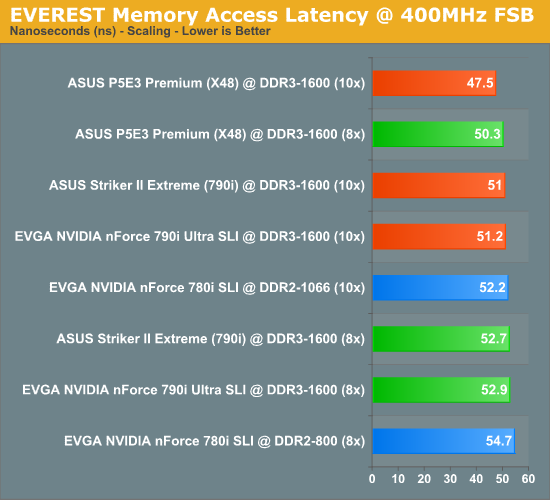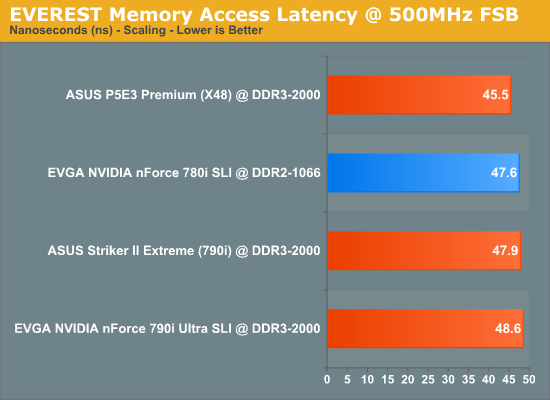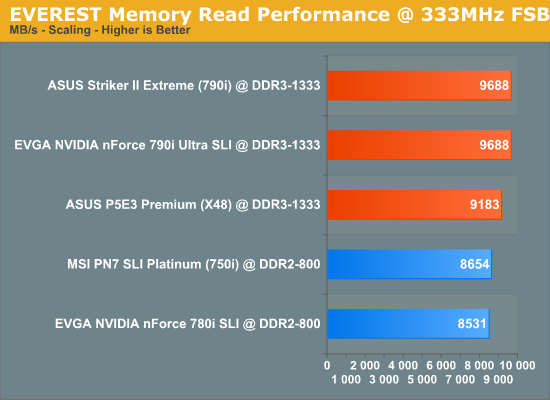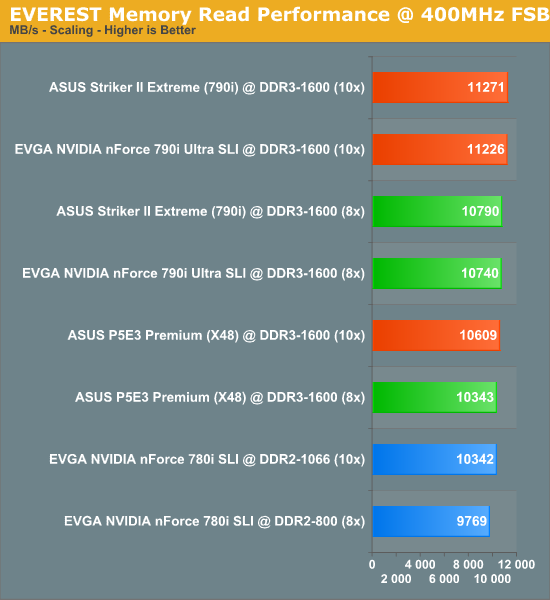ASUS Striker II Extreme: Mucho Bang, Mucho Bucks
by Kris Boughton on April 11, 2008 7:00 AM EST- Posted in
- Motherboards
Memory Access Latency and Read Performance

Each of the DDR3-based motherboard showed about a 10% reduction in random memory access latency figures. As expected, the board with the Intel X48 Express chipset, the ASUS P5E3 Premium, takes the gold in this event.

400MHz FSB showed additional small improvements with even lower memory access latencies. Unlike the boards with an NVIDIA chipset, the ASUS P5E3 Premium showed another nice drop in latency simply by moving to the higher multiplier (overclocking our QX9770 from 3.20GHz to 4.00GHz). As previously noted, these low access times are precisely the reason why UT3 runs so well on our X48 board.

We saw the best memory access latencies of the day with our X48-based P5E3 Premium at 500FSB. The real surprise however came from the EVGA NVIDIA nForce 780i SLI, which showed DDR2 could be nearly as effective at producing low access times as DDR3 when properly tuned.

NVIDIA really surprised us with the quality of their first DDR3 memory controller; besting Intel's X48 design was the last thing we expected to see from 790i. According to these results, even DDR3 value memory outperforms the midrange DDR2 modules flooding the market.

Both EVGA's and ASUS' 790i boards absolutely demolished the P5E3 Premium when it came to raw memory read bandwidth - 500MB/s is a big lead to hold when comparing memory controller performance with memory running at equivalent speeds. The extra 10% memory read throughput seen with DDR3-1600 over DDR2-1066 shows up well in some of the gaming benchmarks. This goes a long way towards dispelling the early, unsubstantiated rumors of lackluster performance from DDR3 memory.

The 790i pulls even farther ahead when the FSB is increased to 500MHz. Intel's X48 Express chipset begins to run out of steam at around 465-475MHz FSB. The same would be true for NVIDIA's 790i Ultra if it were not for the cryptic "P1" and "P2" BIOS options.










23 Comments
View All Comments
takumsawsherman - Saturday, April 12, 2008 - link
But for $400, you only get Firewire 400. Is that like a key, or something? If we pay $800 for a board, will they finally feel as though they can afford to add Firewire800, as Gigabyte did on their $200 boards like 3 or 4 years ago?When they talk about adding firewire itself to a board, does it never occur to them that a faster variation has existed for 5 or 6 years now? How insulting.
Grandpa - Saturday, April 12, 2008 - link
It doesn't matter what the price, performance, make, or model. If the board is unstable I don't want it! I had an Abit board once with a VIA chipset. It corrupted data when large files were transferred between drives. Several BIOS updates later, with the performance down to a crawl, it still corrupted data. Because of that ugly bad memory, stability is number one important for me. So this review is very relevant to others like myself.Super Nade - Friday, April 11, 2008 - link
As far as I know, the capacitors you mention are made by Fujitsu's Media division (FP-Cap series), not Fairchild semiconductor. Fujitsu did try to gobble up Fairchild in the 80's, but the US government killed the deal. Apart from this, I am not aware of any connection between these two companies.Here is the link--> http://jp.fujitsu.com/group/fmd/en/services/capaci...">http://jp.fujitsu.com/group/fmd/en/services/capaci...
S-N
Stele - Saturday, April 12, 2008 - link
Super Nade's right. The vendor marking on the capacitors - which have been the same for almost all such solid electrolytic polymer caps used on Asus boards for some time now - is very much that of Fujitsu: a letter 'F' in Courier-esque font between two horizontal lines.Interestingly - and confusingly - however, once upon a time this logo was indeed that of Fairchild Semiconductor... the deal that almost happened in the 80s may have something to do with Fujitsu's current use of the said logo. Either way, Faichild Semi have long since changed to their current logo (a stylised italic 'f') so today, any current/new electronic/semiconductor component carrying the F-between-bars logo is almost certainly a Fujitsu product.
jojo29 - Friday, April 11, 2008 - link
Just wondering how the Anandtech's Choice P5E3 Premium ( which i plan on buying) stacks up against this Striker? Any comments? Or did i miss something in the aricle as i was only able to skim through it, as im at work atm, and dontcoughwantcoughtogetcaughtbymybosscough...kjboughton - Friday, April 11, 2008 - link
We used one X48 motherboard in this review and it was the ASUS P5E3 Premium. Enjoy the full read when you make it home. ;)ImmortalZ - Friday, April 11, 2008 - link
You mention that overclocking the PCI-E bus provided tangible performance benefits on the EVGA board.Did you read about the rumblings around the net about some G92 based cards overclocking their GPU with the PCI-E bus? There are supposedly two clock sources for these type of cards - one on board and the other slaved to the PCI-E bus.
Are you sure that the performance improvement is not because of this anomaly?
CrystalBay - Friday, April 11, 2008 - link
Hi Kris, while UT3 does scale very well with multi-core. The game it self has no DX10 support as of yet. Hopefully EPIC will will enable it in a future update...Glenn - Friday, April 11, 2008 - link
All the benchies and comparisons are great, but how does it compare to a P35 board? A 965 or X38 board? I doubt you will convert those that already own an X48 and I (P35) have no point of reference within this article to see if I'm 5, 10 or 25% behind the preformance curve?Rolphus - Friday, April 11, 2008 - link
Interesting review... only one question though. Why use the 32-bit version of Crysis on Vista x64? Is there an issue with the 64-bit version that I don't know about?